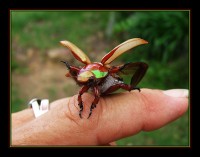Yesterday as I walked around our garden I was struck by the absence of insects. Of course they are there hidden away, but in Australia – at least when I was young – it seemed they were everywhere at all times; almost unavoidable. And during those days, back when I was a little boy, this was my toy of choice:
It was called the ‘Bug Catcher’. It is difficult to find information online so my guess is it may have been only Australian (although use of the American ‘bug’ suggests otherwise). The idea was you hold the thing around the narrow bit, remove the green base from the bottom, and scoop up bugs (without touching them, obviously) before putting the cap back on. The insects can then be kept inside the device, which includes air vents and a second cap at the top through which you can put food (or insert more bugs).
I had at least 2 of these when I was a kid. I broke the first one by falling on it and quickly got another. During the long hot summers I would use it often to catch all sorts of insects, which I would then keep as ‘pets’ in an assortment of habitats.
These are the guys I used to go after the most:
The green guy on the left is a slantface, and the one on the right is a locust. In other words: grasshoppers.
Grasshoppers were absurdly common in Australia. We never lived far from bushland or a field, and it was virtually impossible not to find grasshoppers in abundance were I interested in catching some. Australia has many different species of all shapes and sizes, but the real prizes were the big guys such as those above (each of which can grow upwards of 7 cm).
I’d scoop them up in my Bug Catcher (or when I was a big older, just grab them) and keep them in shoeboxes filled with grass or in big gherkin jars with holes punched in the lids for air. Sometimes I’d release them at the end of the day, sometimes I’d keep them for a few days. Often they would die – which never really bothered me as a child – and I’d just go and get more. I recall I used to be delighted if they actually ate in captivity because it was a sign to me they were ‘happy’ 🙂
Here’s a creeper I definitely used the Bug Catcher for:
That’s a spitfire caterpillar. Eventually it turns into a moth, but as kids we didn’t care too much about it’s future because this form was what interested us most. You see the urban legend was that if you were to touch those little spiny bits you’d get a nasty sting. Was it true? Who knows. I can certainly say I don’t remember touching one, and the few times I caught them to keep them carefully scooped them up in the catcher to avoid doing so.
Here’s another guy I used to love catching and keeping for a few days:
It’s called s a Christmas Beetle, a type of scarab so named because it is usually abundant around Christmas (mid summer) in Australia. Large and docile creatures, these guys were easy to pick from trees and bushes. They would sit on your shirt like a cicada and look beautiful in the sun (the best examples were burnished like gold). I recall I used to be upset when a beetle wouldn’t fold his wings away perfectly, and would occasionally fiddle with his carapace and wings to ‘help’ him appear less messy 🙂
I’d also use the catcher to sift things out of soil (usually woodlice or tiny spiders), to scoop up praying mantises or stick insects, to catch butterflies (which I would always release) and even to catch spiders. I also took it to the beach a few times and used it in rockpools for crabs! As I got older I became less scared of handling the beasts directly and the catcher was put away and eventually forgotten. But for a few glorious summers… that plastic toy was the world for me.






Yikes! I wish we had those Spitfire Caterpillars in this country. Thiis is one of your best blogs ever 🙂
We used to fear those spitfire caterpillar.
Years ago I think I might have been stung by one. I once felt a piercing sensation in my wrist much like a needle after lying on the ground. There was a small red bump for a few days. I don’t know what caused it but there was a spitfire on the ground in the general area it happened. Although it could have been some other insect, or even just a sharp stick.